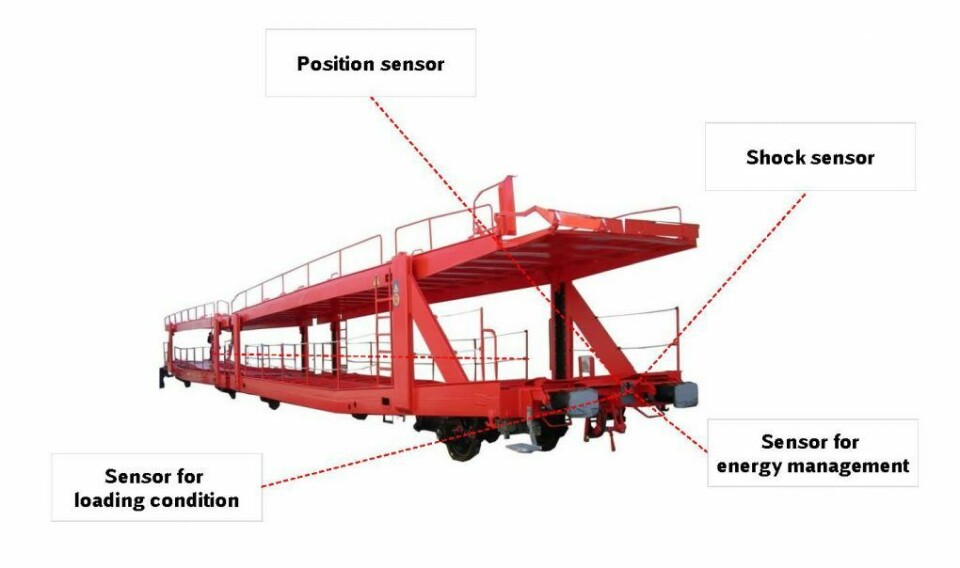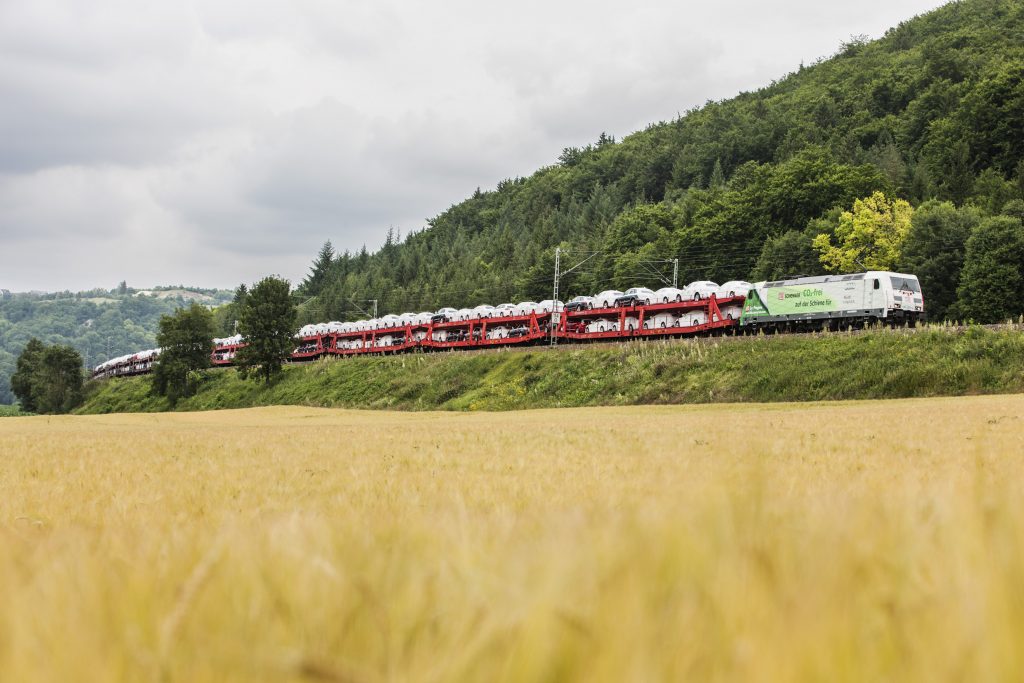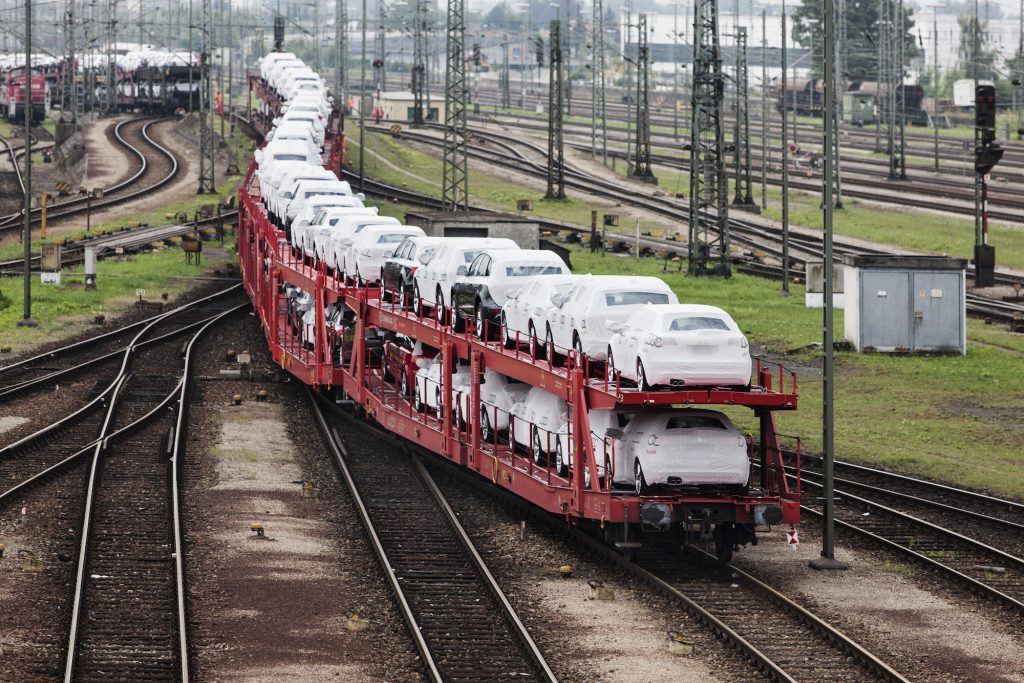A new train of thought

Illustration copyright DB Schenker Rail Automotive GmbH
Vehicles are increasingly moving towards connected cars and trucks. Now may be the time for the connected rail wagon. DB Schenker is currently trialling what it calls 'asset intelligence', and other rail providers are considering their options too
Connected cars are increasingly the norm for newer models. Although offerings vary, almost every OEM is now selling connectivity, whether it be mobile internet access, wireless networks, voice commands, emergency assistance or parking apps, with features that include remote monitoring and diagnostics. OEMs and tech companies are well into the development of autonomous cars, with some planning to have driverless cars on the road as early as 2020. Trucks are at it, too. Mercedes-Benz’s Future Truck – an autonomous truck with platooning potential – could change the logistics world forever. Perhaps more mundanely, but nevertheless importantly, many trucks in automotive logistics fleets use GPS for monitoring or tracking in some way.
So far there hasn’t been much in the way of ‘connected rail’ developments, at least for the automotive sector. However, DB Schenker recently revealed that it is working on ways to connect its wagons and rolling stock with the use of sensors, while also planning further automation of its processes.
Supply chain visibility is an ever-present and ongoing issue in logistics. Companies such as DHL and UPS can offer customers complete visibility on the smallest, cheapest package, but the automotive industry has not managed to achieve the same with its much more expensive products. DB Schenker wants to improve visibility levels with a series of sensors, or ‘asset intelligence’ as the rail company is calling it. Harald Schulze, project manager for asset intelligence at DB Schenker Rail, and Malte Keller, head of equipment for DB Schenker Rail Automotive, speak in detail about the new technology, and the benefits it could bring to the movement of vehicles on the railways.
What technological developments is DB Schenker working on that could benefit automotive logistics?
Asset Intelligence represents one major technological development within DB Schenker Rail. Through the introduction of intelligent rail wagons, the railway industries will advance significantly, and the project is expected to have sizeable, beneficial effects on our customers and DB Schenker.
How will your intelligent rail wagons be connected?
Our rail wagons will be equipped with wagon-type specific and other sensors that will provide further data about the entire supply chain. These sensors will communicate via GPS and UMTS (Universal Mobile Telecommunications System) and deliver the data into our system, where it will be processed and combined with present data. Processes that are currently manual could be automated in the future.
 Malte Keller, head of equipment for DB Schenker Rail Automotive
Malte Keller, head of equipment for DB Schenker Rail AutomotiveWhat are the challenges of implementing your asset intelligence technology?
There are various challenges. First, we face the issue of technological feasibility. Generating the data will require technological development of the various sensors, and we also need to adapt to the prevailing operational conditions in the railway transportation industry. Once we have solved the technical feasibility and the data is generated, the digital infrastructure, which is responsible for delivering the data, becomes a constraint. However, we have already seen significant progress in this area. The next challenge lies within the operating company itself. We will need to share the benefits with our customers, and make changes from our current processes. So far, DB Schenker has accepted the challenges and mastered the first critical steps towards implementing this new technology.
 Harald Schulze, project manager for asset intelligence at DB Schenker Rail
Harald Schulze, project manager for asset intelligence at DB Schenker RailWhat will the benefits of connected rail wagons be?
Asset intelligence will provide a bunch of benefits for both customers and DB Schenker. Automating and adjusting current processes will result in better efficiency for our operations for a start. When this is combined with the benefits to maintenance, the asset intelligence can also positively affect wagon availability and reliability. Shipment tracking and a higher level of visibility of freight wagon activities will be possible for all our customers. The information we receive will also help with cross-border transportation. We will also be able to prevent issues: a shock sensor can detect possible damages so that adequate and proactive measures can be taken to ensure safe transportation.
How will sensor technology on freight wagons increase supply chain visibility?
The information gathered from the sensors will assist in portraying relevant activities within the supply chain. The data from several sensors combined will help us to visualise the steps from vehicles arriving at the customer, to unloading and loading. From a customer perspective, the sensors can provide information about the quality of transported freight, a more accurate forecast of arrival, and the order of the freight within the train so that a customer’s supply chain can be optimised.
What will the sensors you add to your wagons measure?
The sensors that will be mounted on rail wagons will be specific to the type of wagon, but there will be common basic equipment for all wagons. Automotive rail wagons will be fitted with sensors that deliver information on tracking and tracing, mileage, shocks, and loading conditions. The track-and-trace sensor will provide information about the position and the mileage of the automotive wagons. Sensors can also detect possible shocks, which can affect the condition and cause damage to vehicles. The registration of the loading condition will be specific to the wagon type, and the data will show whether the rail wagon is loaded or unloaded. Through a combination of data from several sensors, we will be able to get even more information.
How do you currently monitor and track freight, and how much will it change with the new technology?
Nowadays we maintain EDI-interfaces of relevant production systems of several European railway companies, and we import the data into our internal wagon system, so we can monitor general information about our wagons all across Europe. However, the quality and quantity of this data varies in different countries, so, depending on the location, we can have smaller and larger gaps where we do not receive enough information or as many updates as we need about our wagons. With the help of asset intelligence, we can reduce and close these gaps in the future.
What is the proposed timeline for asset intelligence in automotive wagons?
We are currently equipping and testing a pilot fleet in which both open and covered car carriers will be included. The automotive rail wagon equipment should be completed within the first half of 2016. From there, the wagons will enter a one-year test period in order to evaluate the technical requirements and the expected benefits. Subsequently, we will decide about the relevance of each sensor together with our customers and, if we have a positive test period, we will install the equipment in further automotive wagons. As DB Schenker has a vast rolling stock, it is likely we will have to prioritise equipping our wagons for specific cargo and wagon types. However, this depends on the findings during the pilot phase.
 DB Schenker's trials with sensors aim to push automotive-related rail into the digital age, though other rail providers in Germany and Europe are taking a more cautious approach (image copy right DB Schenker Automotive Rail GmbH)
DB Schenker's trials with sensors aim to push automotive-related rail into the digital age, though other rail providers in Germany and Europe are taking a more cautious approach (image copy right DB Schenker Automotive Rail GmbH)What sort of return on investment will this technology offer?
Quantifying the return on investment is challenging. However, an inter-divisional task force will address the positive effects during the course of the pilot phase. The main outcomes that we expect are customer retention and the savings potential in wagon management and routing, and maintenance.
Do you think this asset intelligence technology will be something your customers will be happy with?
There is no doubt that customers will benefit from asset intelligence. Apart from the fact that we will be improving on our standard promises with respect to reliability, availability and quality, asset intelligence will also provide additional services for our customers. Integrating data into the customers’ database, or having more, and better data in our portal will help our customers to optimise their supply chain. Consequently, asset intelligence will assist our customers in speeding up their processes.
Is the technology just slated for automotive wagons, or for other goods as well?
We will provide this service to all of our customers. Use cases and the timeline of equipment may vary from automotive wagons depending on wagon type and freight.
Are you aware of any other companies that are digitalising trains like you are?
The trend towards digitalisation is ubiquitous in the railway transportation industry, as we have seen during various expert conferences.
 Other rail companies in Europe, including BLG and ARS Altmann, are exploring several options to improve tracking (image copyright DB Schenker Automotive Rail GmbH)
Other rail companies in Europe, including BLG and ARS Altmann, are exploring several options to improve tracking (image copyright DB Schenker Automotive Rail GmbH)DB Schenker suggests that digitisation is “ubiquitous” for the railway industry. That may be the case for the wider cargo sector and passenger services – DB Schenker, for example, is also looking to introduce driverless trains into parts of its network – however, for automotive-related rail, such asset intelligence may not be quite as advanced.
Thomas Bamburg, managing director of BLG Autorail, which has a large fleet of rail wagons, says it doesn’t use such technology in its operations, as most traffic is done in block trains within central Europe, which can be monitored easily by using information provided by the railway companies and at loading and unloading terminals. “If our activities extended more into Turkey in the future, we would think about using mobile GPS-devices to monitor trains on this route,” he reveals.
Although BLG isn’t currently using connected technology, Bamburg acknowledges it may be more necessary in the future. “Available information on rail movements will decrease the more small, privately operated railway companies will enter the freight market. The smaller the company, the less information will be available in real-time,” he explains. He also suggests that information on freight movements will become a service for which rail companies will charge their customers.
Bamburg thinks connected rail technology will be of maximum benefit if a high percentage of traffic is operated in single wagons or wagon group business, but it may still take some time until the advantage of real-time information will enable transport companies to cover the technology’s costs.
Matthias Prochazka, head of rail operations at ARS Altmann, based in Germany, agrees that the investment in such technology would be significant. At Altmann, for example, it would involve equipping 2,700 wagons with sensors. “Damage from shunting is quite unlikely and does not happen very often, so we don’t see the necessity to install such technology, for the moment,” he says.
Altmann constantly tracks and evaluates systems on the market, and the multimodal provider is especially interested in products that can help with wagon maintenance. Altmann currently has a tracking system used for all trains operating within Germany called LeiDis, to monitor its own trains.
“It is the locomotive that is tracked on the system. This allows us to know which wagons are attached to the locomotive, where they departed from, and their destination. Of course we also know the different check points on the journey, and we are able to track the lead time of the trains,” Prochazka says. Since this system is based on the German railway, it would be an advantage to have a single European tracking system to monitor international flows more efficiently.
Matthias Prochazka says that, from a customer perspective, Altmann has not recognised a desperate need for specific sensor tracking systems to follow single vehicles within its trains. Since the majority of volumes transported are going to export markets, Altmann plans delivery times based on ro-ro vessel departures.
Altmann will, however, continue to monitor and test current and future tracking technologies, whether that might be in areas such as RFID and sensors, or more traditional approaches that would include barcodes and scans at key stages.
“There are existing systems but we haven’t decided yet whether we would install one in the near future,” says Prochazka. “We have a couple of wagons equipped as prototypes and we’re testing what data we get out of it.





